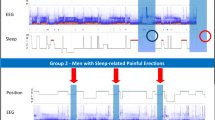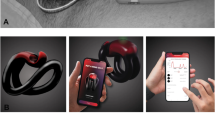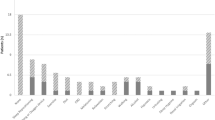Abstract
The objective of this study was to determine the effects of oral phentolamine, administered before sleep, on nocturnal penile erectile activity of men with mild to moderate erectile dysfunction (ED). We studied five patients with mild to moderate ED (mean age 34.8±8.13 and mean duration of ED 31.8±23.5 months), in a double-blind, placebo-controlled, crossover study. All patients received oral phentolamine (VasomaxTM) at a dose of 40 mg and placebo for three consecutive nights respectively and were submitted to nocturnal penile tumescence and rigidity monitoring (NPTR) with the Rigiscan® device. NPTR parameters of the two 3-night recordings were evaluated and compared. Administration of oral phentolamine before sleep was associated with a statistically significant increase in the number of erectile events with rigidity ≥60% lasting ≥10 min (P=0.02), as well as the rigidity activity units (RAU) value per hour sleep, both at the base (P=0.023) and the tip of the penis (P=0.019). The number of events as measured by Rigiscan software (20% change in circumference), as well as tumescence activity units (TAU)/h values did not show any statistical difference. No adverse effects were recorded. It is concluded that oral phentolamine administered before sleep enhanced NPTR parameters associated with the quality of the erectile events. Such results provide a pathway for the development of a prevention strategy for ED. Future studies will elucidate whether vasoactive agents taken on a regular basis before sleep, can prevent ED in men at risk, protecting also minimally and moderately impotent patients to become moderately and severely impotent respectively.
This is a preview of subscription content, access via your institution
Access options
Subscribe to this journal
Receive 8 print issues and online access
$259.00 per year
only $32.38 per issue
Buy this article
- Purchase on Springer Link
- Instant access to full article PDF
Prices may be subject to local taxes which are calculated during checkout
Similar content being viewed by others
References
Johannes CB et al. Incidence of erectile dysfunction in men 40 to 69 years old: longitudinal results from the Massachusetts male aging study. J Urol 2000 163, 460–463
Virag R et al. Intracavernous self-injection of vasoactive drugs in the treatment of impotence: 8-year experience with 615 cases. J Urol 1991 145, 287–292
Sarlip ID . Does natural erectile function improve following intracavernous injections of vasoactive drugs? Int J Impot Res 1997 9, 193–196
Montorsi F et al. Recovery of spontaneous erectile function after nerve-sparing radical retropubic prostatectomy with and without early intracavernous injections of alprostadil: results of a prospective, randomized trial. J Urol 1997 158, 1408–1410
Moreland RB . Is there a role of hypoxemia in penile fibrosis: a viewpoint presented to the Society for the Study of Impotence. Int J Impot Res 1998 10, 113–120
Goldstein I et al. Oral sildenafil in the treatment of erectile dysfunction. New Engl J Med 1998 338, 1397–1404
Goldstein I . Oral phentolamine: an alpha-1, alpha-2 adrenergic antagonist for the treatment of erectile dysfunction. Int J Impot Res 2000 12, (Suppl 1): S75–S80
Cappelleri JC et al. Diagnostic evaluation of the erectile function domain of the International Index of Erectile Function. Urology 1999 54, 346–351
Hatzichristou DG et al. Nocturnal penile tumescence and rigidity monitoring in young potent volunteers: reproducibility, evaluation criteria, and the effects of sexual intercourse. J Urol 1998 159, 1921–1926
Hatzichristou DG . Current treatment and future perspectives for erectile dysfunction. Int J Impot Res 1998 10, (Suppl 1): S3–S13
Padma-Nathan H, Linet O, Sheu W . The impact on return of spontaneous erections of short term Alprostadil therapy post nerve sparing prostatectomy. J Urol 1997 157, 363 (1422A)
Nehra A et al. Mechanisms of venous leakage: a prospective clinicopathological correlation of corporeal function and structure. J Urol 1996 156, 1320–1329
Daley JT et al. Prostanoid production in rabbit corpus cavernosum: I. regulation by oxygen tension. J Urol 1996 155, 1482–1487
Shabsigh R et al. Comparison of penile duplex ultrasonography with nocturnal penile tumescence monitoring for the evaluation of erectile impotence. J Urol 1990 143, 924–927
Chung WS, Park YY, Kwon SW . The impact of aging on penile hemodynamics in normal responders to pharmacological injection: a Doppler sonographic study. J Urol 1997 157, 2129–2131
Levine LA, Carroll RA . Nocturnal penile tumescence and rigidity in men without complaints of erectile dysfunction using a new quantitative analysis software. J Urol 1994 152, 1103–1107
Sohn MH, Seeger U, Sikora R, Jakse G . Criteria for examiner-independent nocturnal penile tumescence and rigidity monitoring (NPTR): correlations to invasive diagnostic methods. Int J Impot Res 1993 5, 59–68
Hatzichristou DG et al. RAU's and TAU's: more confusion or more information. Int J Impot Res 1996 8, 109 (A41)
Traish A et al. Phentolamine mesylate relaxes penile corpus cavernosum tissue by adrenergic and non-adrenergic mechanisms. Int J Impot Res 1998 10, 215–223
Lue TF, Goldstein I, Traish A . Comparison of oral and intracavernosal vasoactive agents in penile erection. Int J Impot Res 2000 12, (Suppl 1): S81–S88
Heaton JPW, Adams MA, Morales A . A therapeutic taxonomy of treatments for erectile dysfunction: an evolutionary imperative. Int J Impot Res 1997 9, 115–121
Montorsi F et al. Sildenafil taken at bed-time significantly increases nocturnal erectile activity: results of a prospective Rigiscan® study. J Urol 2000 163, 148 (657A)
Kim NN, Goldstein I, Moreland RB, Traish AM . Alpha-adrenergic receptor blockade by phentolamine increases the efficacy of vasodilators in penile corpus cavernosum. Int J Impot Res 2000 12, (Suppl 1): S26
Acknowledgements
This work was supported by the Schering-Plough Corporation.
Author information
Authors and Affiliations
Corresponding author
Rights and permissions
About this article
Cite this article
Hatzichristou, D., Apostolidis, A., Tzortzis, V. et al. Effects of oral phentolamine, taken before sleep, on nocturnal erectile activity: a double-blind, placebo-controlled, crossover study. Int J Impot Res 13, 303–308 (2001). https://doi.org/10.1038/sj.ijir.3900731
Received:
Accepted:
Published:
Issue Date:
DOI: https://doi.org/10.1038/sj.ijir.3900731
Keywords
This article is cited by
-
Phentolamine relaxes human corpus cavernosum by a nonadrenergic mechanism activating ATP-sensitive K+ channel
International Journal of Impotence Research (2005)



